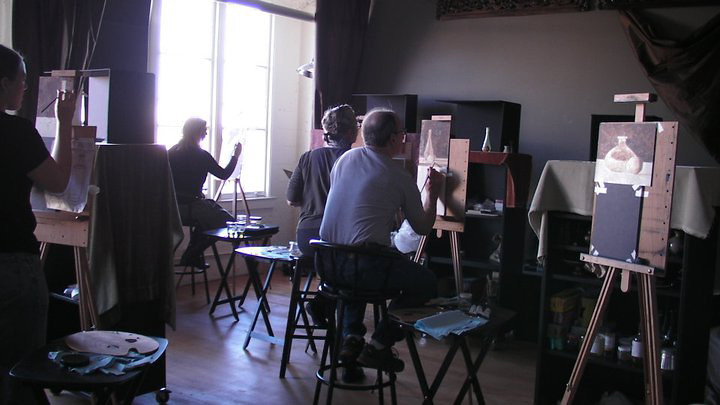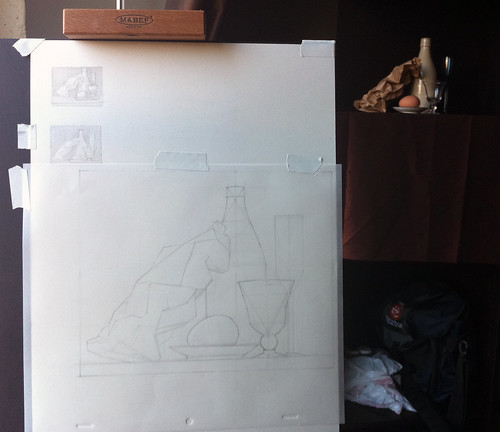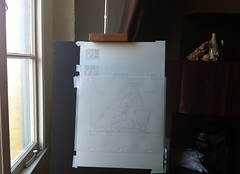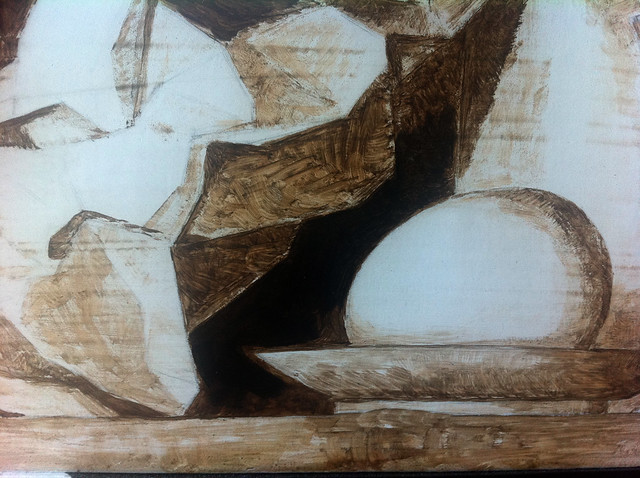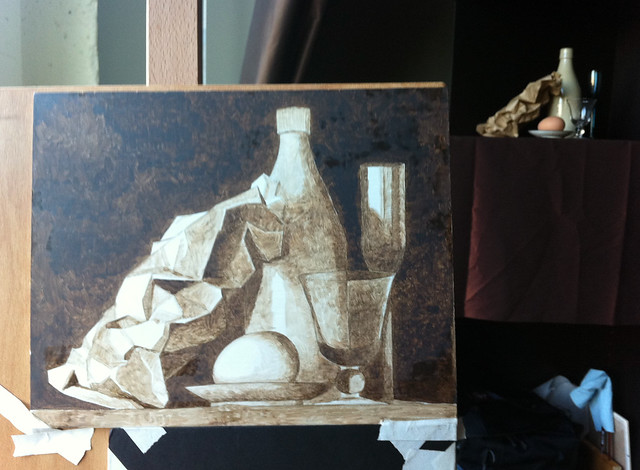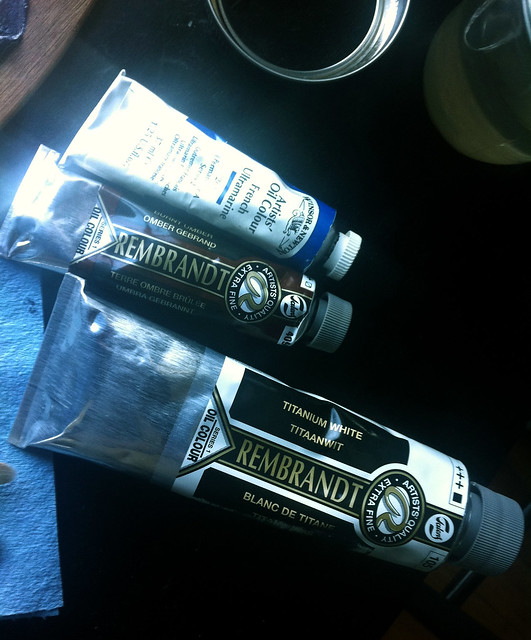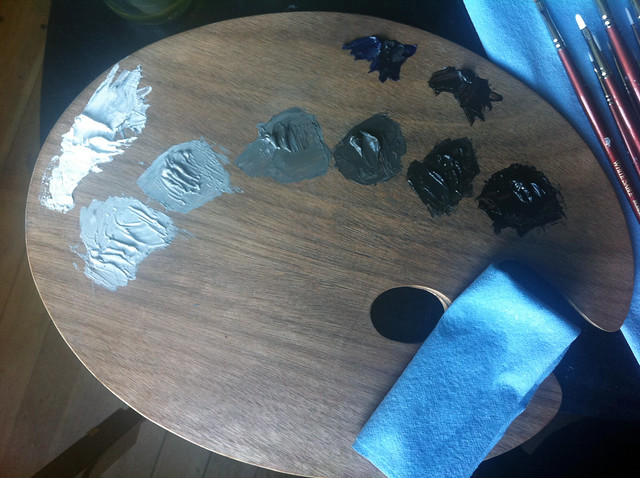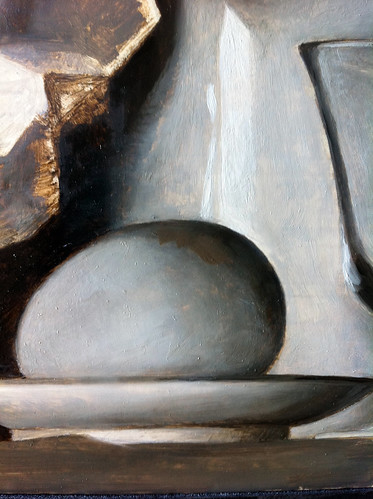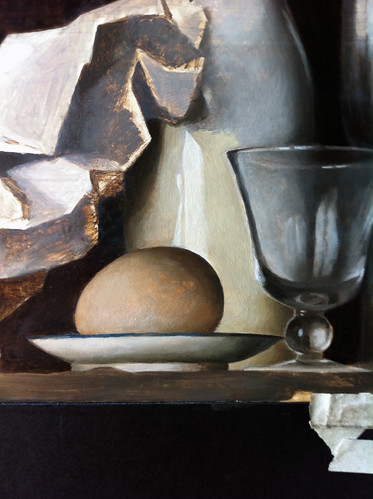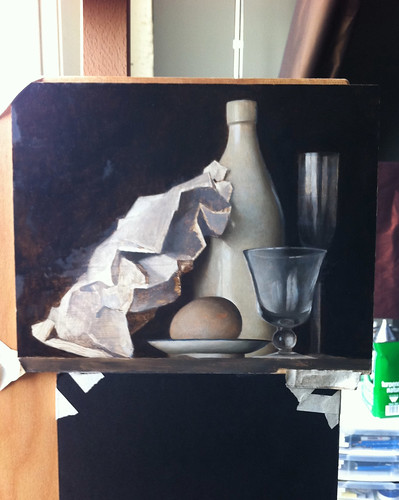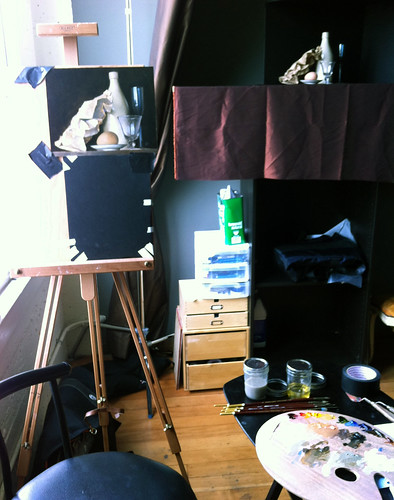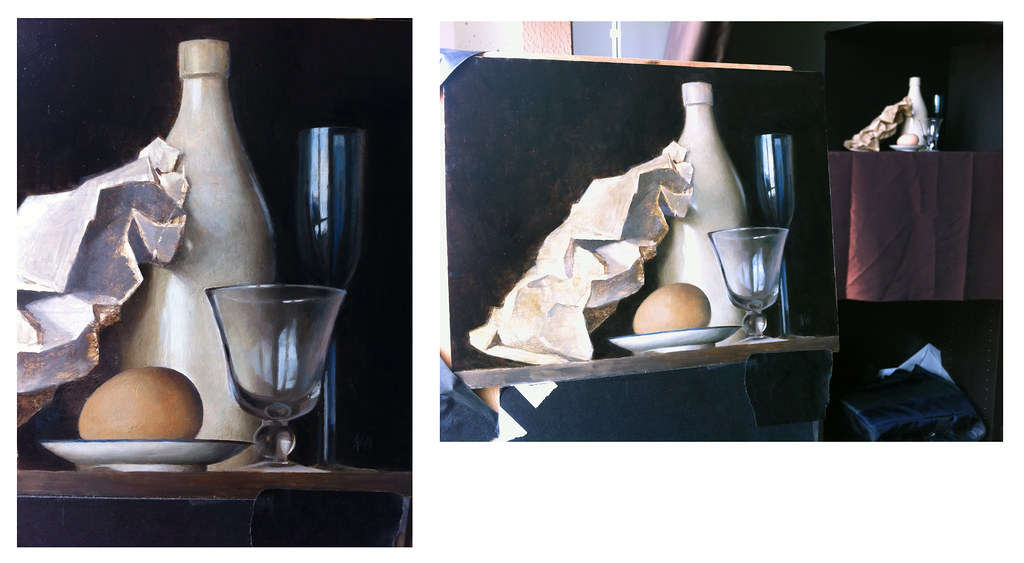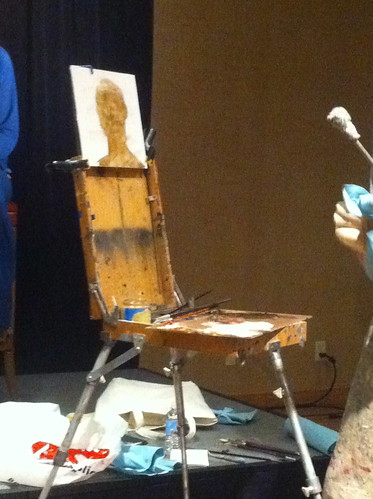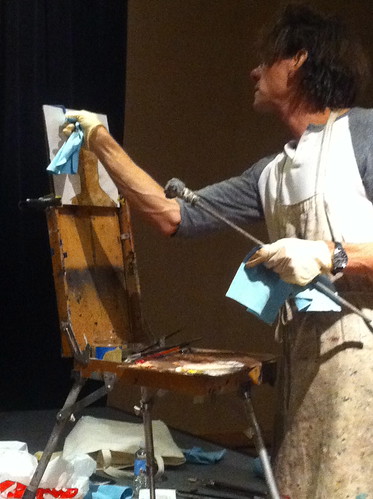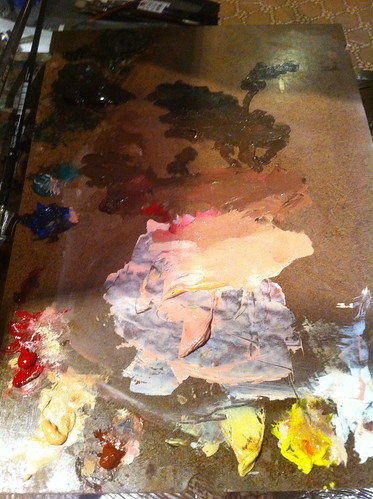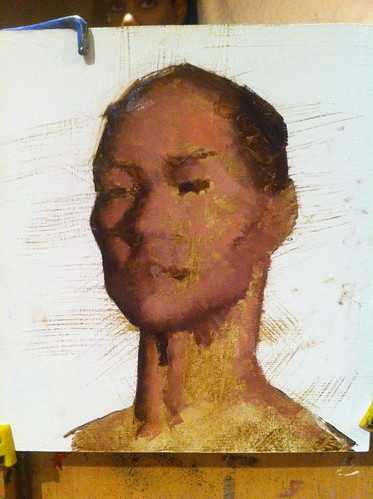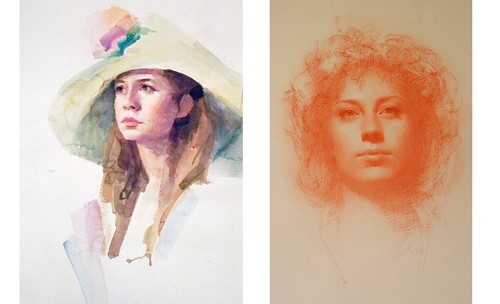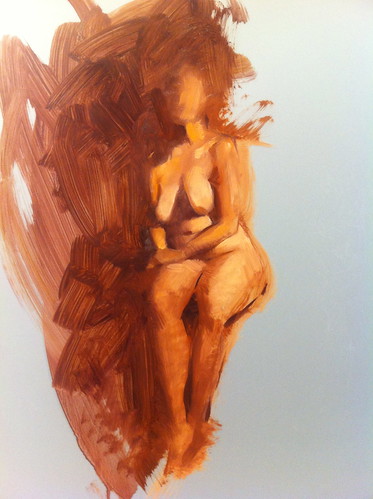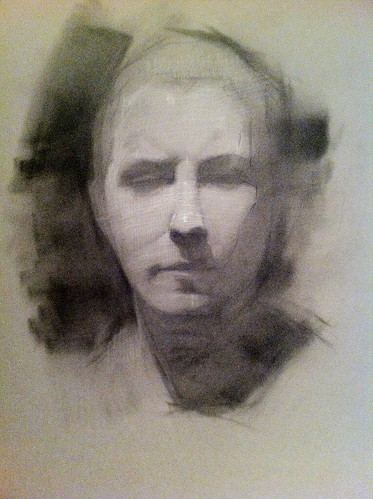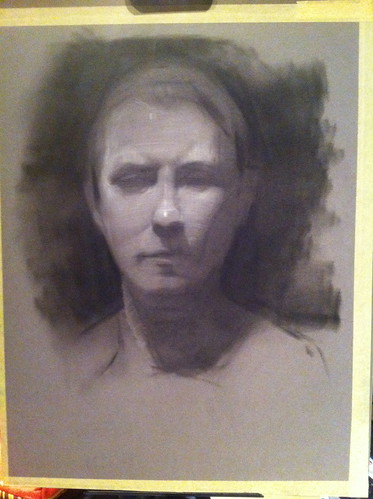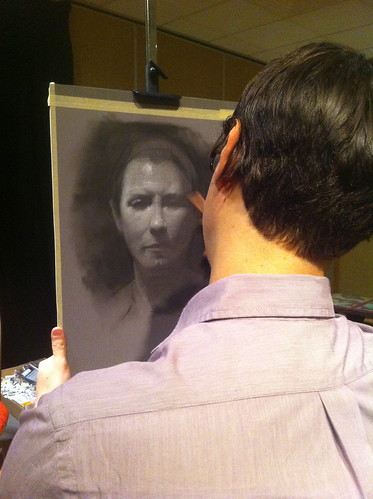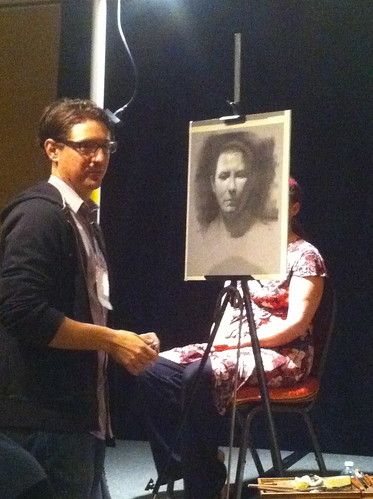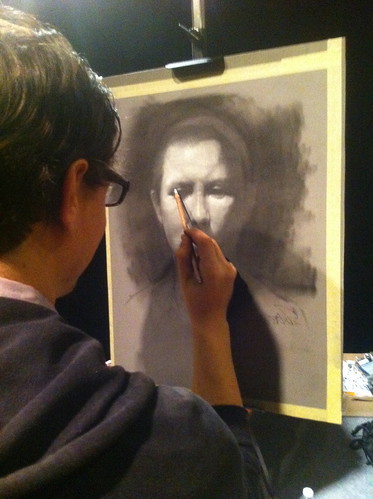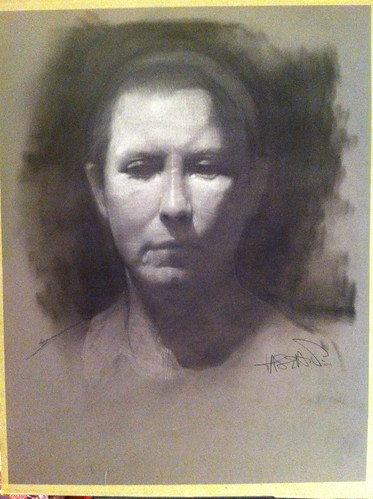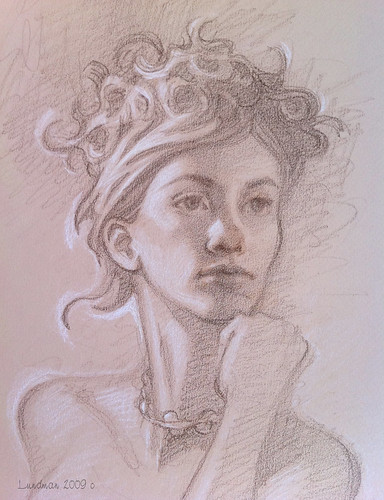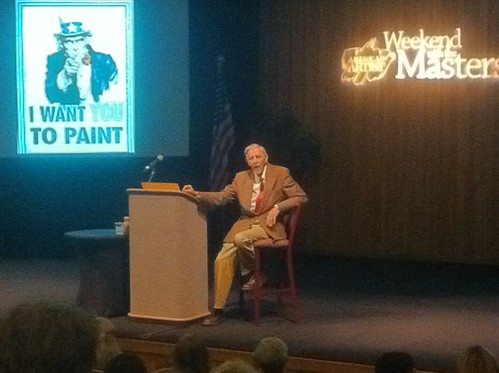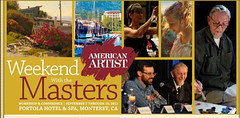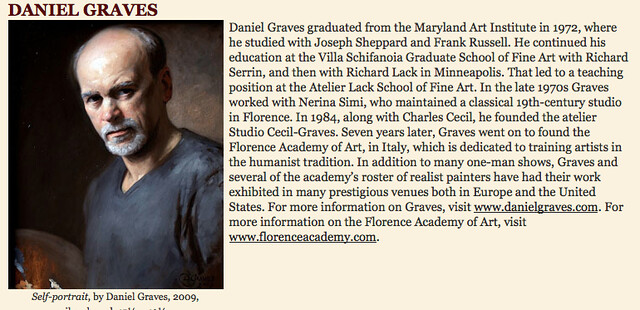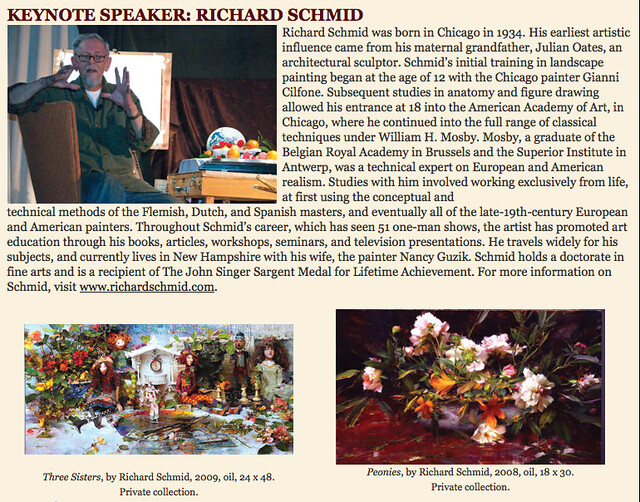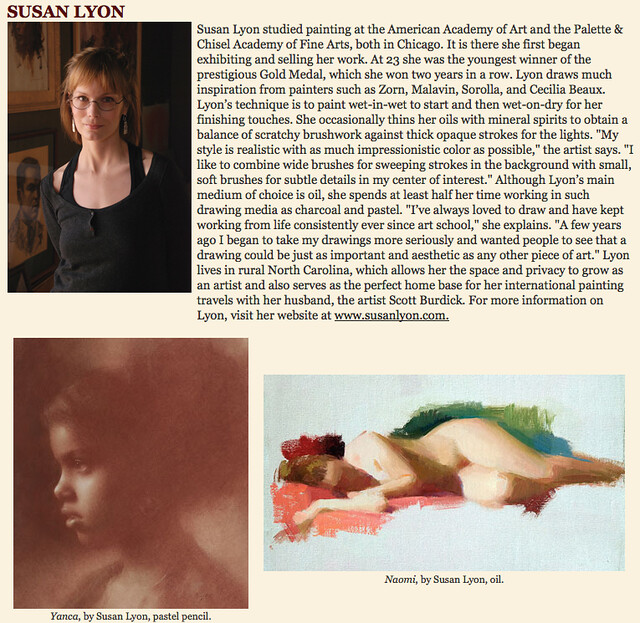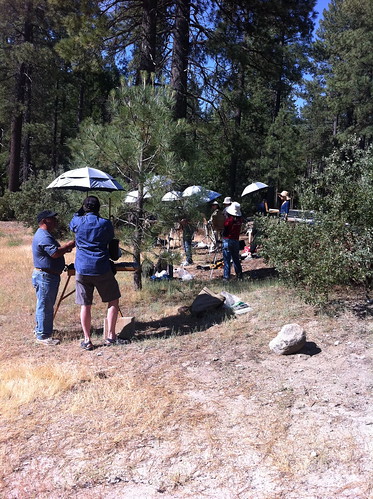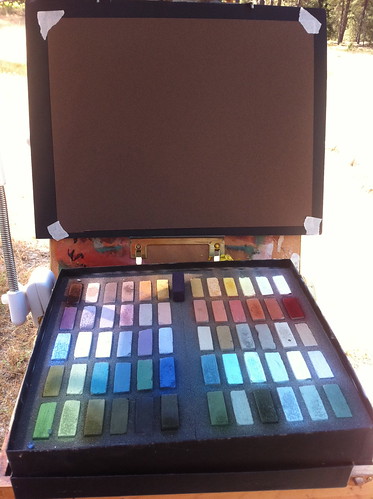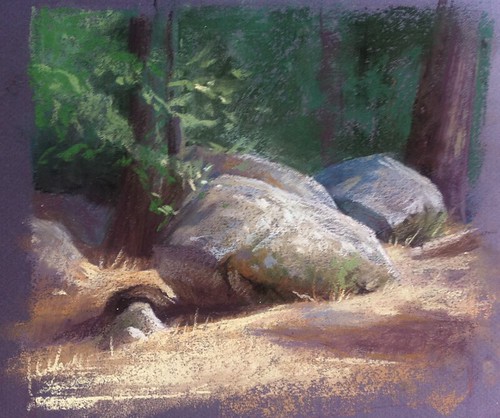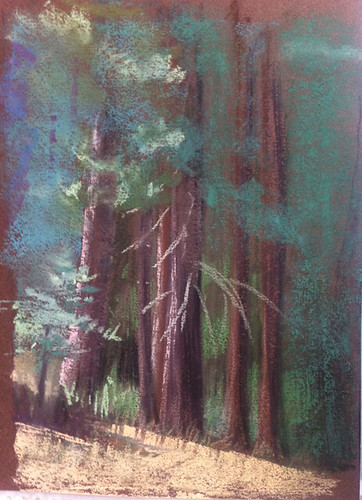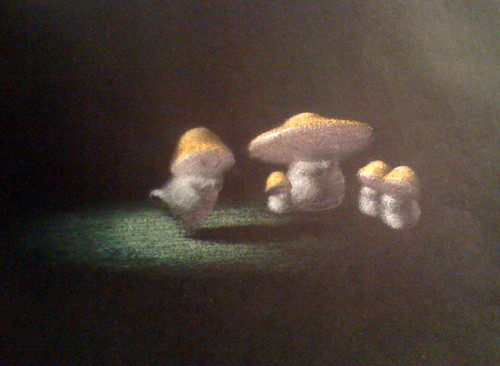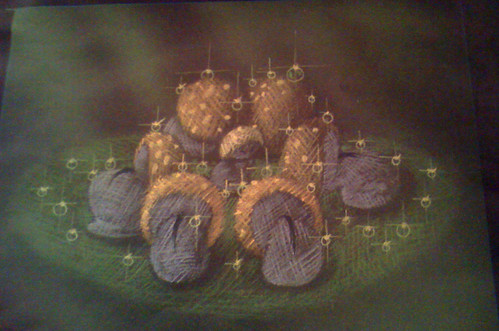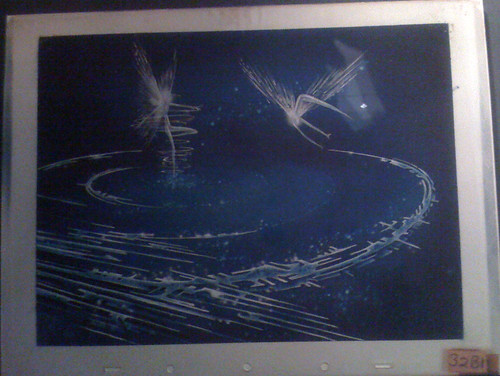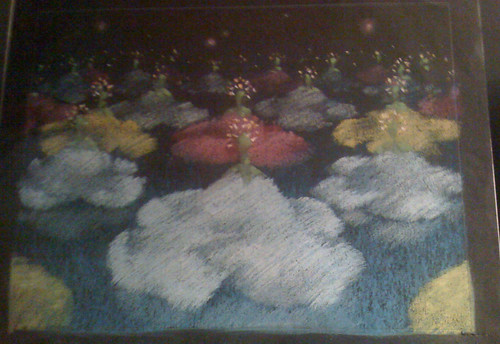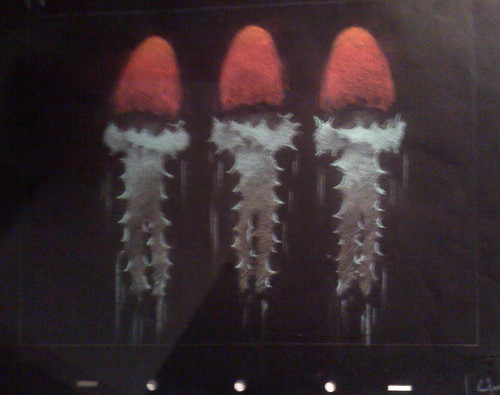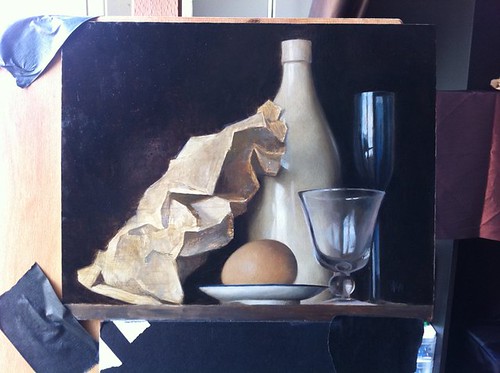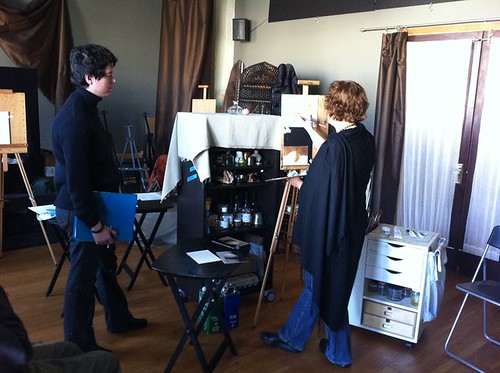"LOSING TIME", Poster Roughs
CTN Ad
This year I took up the opportunity to advertise in the CTN Sketchbook, a collectible printed sketchbook you can buy. I created this ad using some of my art. The book is in black and white, and because of that I submitted this piece in black in white. The 2015 sketchbook should be available in a few weeks at the

I liked the composition a lot, so I also created it in color, too. I also made a bookmark of "The Act". I will have both color bookmarks while at the show. If you see me ask for one - they're free! Ping me at @Paintkatt on Twitter if you're at the show and want a bookmark!

Thanks for reading!
BACCA workshop with Michael Klein
This summer I have been very busy taking a Maya modeling class while I am also working on a personal project. Although most of the work I've been doing involves staring into my computer screen for most of the day, when I heard artist Michael Klein would be teaching a floral still life workshop at the Bay Area Classical Artist Atelier, otherwise known as BACCA, I jumped at the chance.
Here are just a few examples of Michael Klein's work, focusing on his florals. His work encompasses figures, still lives, and semi-narrative pieces, all done in a painting manner that brings the spirit of the subject to life with energetic, yet carefully planned brushwork. Much more of Klein's work can be seen on his website:
I love the textures and depth that he paints in his floral arrangements. They remind me a little of Fantin Latour florals while still being all his own.
Michael Klein's progress shot from his blog on his website. GORGEOUS!
********************************************************************
BACCA
********************************************************************
Materials
Old Holland Viridian Green Deep
Michael Harding Raw Sienna
W and N Yellow Ochre Pale
W and N Cadmium Yellow Pale
Rublev Lead White no. 2
OH Cad. Orange
W and N Burnt Sienna
W and N Perm. Alizarin Crimson
OH Quincinadrone Magenta
W and N Cobalt Violet
W and N Cobalt Blue
OH Ultramarine Blue
OH Ivory Black
OH Raw Umber
OH Burnt Umber
Mediums used were simply Gamsol for cleaning brushes, which he uses mostly on the first day to thin down the paint a little if it's too thick or sticky. After day one, he uses a widely known mixture known as "fat medium", equal parts linseed oil plus damar varnish. In later stages of his paintings, he makes use of Rublev Oleogel to thicken up paint strokes and add texture. Paint rags were Viva paper towels.
I did not have Oleogel for the class, so Michael gave me a tiny smidgen to test out. The gel is used for glazing, but also for adding body and flow to the oil paint on top layers. It is truly amazing stuff. I ordered a big vat of it along with the lead white. Michael noted that with Lead White he will sometimes mix it with a few drops of walnut oil to loosen up the stiff mixture. (He also uses stack white from Rublev to create texture, although he wasn't using it in this workshop.)
Michael's custom brush set right under that tube of paint.
*****************************************************************
Each of the four days of Michael Klein's workshop, he worked on a painting demo. He typically spends about 3-4 days working on a floral still life.
Mixed in with his natural flowers were two artificial flowers, which he doesn't like to use but did for this class. He noted that when flower companies make good quality artificial flowers, they mimic natural color patterns of the flower, like spray painting the joints of the stems and leaves with a little brownish overlay instead of one uniform green and will also boost saturation of petals. When using artificial flowers, you will need to understand the methods that manufacturers use to make their flowers appear real and compensate by using your observation and knowledge of real flowers. However, use real flowers whenever possible.
As for color mixing in general, he explained that he doesn't like to overmix his colors on the palette, but instead "loosely" mixes, keeping a bit of each original color separate, so that when the colors move on to the brush and then the painting, a light effect mixes them in our eyes, producing a color vibration. This is a technique I've seen before and used myself, especially with pastel paintings, and also have read about. Golden aged Illustrator Haddon Sundblom's painting method included using two pure colors on one brush to create a mixture directly on the canvas. I'm not sure if this method is an innovation by the Impressionists, but the idea of vibrating color via broken color and paint layers feels impressionist to me.
Also, regarding color mixing on the palette, Michael encouraged everyone to create a "puddle of color" that is essentially a color portrait of the thing you are painting, otherwise you will end up with a lot of muddled color. My own tendency to dance around the palette with all sorts of mixtures usually leads to confusion at times, which I need to work on correcting. He does not create "strings" of color on the palette, instead he creates the middle hue, shadow and light hues all in one puddle.
During his demo, he spoke a bit about using a combo of observation vs. knowledge of form. He explained that Jacob Collins emphasized a thorough understanding of form and how light moves across it, and it was when he finally understood what that meant, that he finally made some breakthroughs in his work. He went on to explain that after painting the initial gesture on the first day, he will start thinking about what he knows about how light reacts on the surface of particular forms. Often, he will not look at the still life but instead focus on the object being painted, paying attention to the direction of the light source and modeling the form so that it reads clearly while still maintaining the beauty of the still life.
This becomes particularly necessary when painting subjects like flowers, which change each day. When asked about his atelier training compared to how he paints now, he explained that in his current work, he is now concerned with evoking a mood or a feeling rather than rendering every bit of the subject in front of him, trying to find that balance between the truthful statement vs. gesture.
For form painting demos, Michael recommended the excellent form painting lessons by fellow Grand Central graduate, Scott Waddell. I've seen all of Scott's videos and they are indeed incredibly useful.
My final painting, which I've cropped to make a more attractive composition.
On the fourth and final day, Michael helped me at the end make some value relationship adjustments and talked with me about editing to the highlight, which did not serve the overall painting as it was too eye catching and distracted from the main subject. His emphasis throughout the workshop was always on the final, poetic statement rather than a 1:1 rendering of the subject, which I agree with wholeheartedly.
Michael Klein's finished four day demo.
During his demo on the fourth day, he spent some time working again on the main white rose, making shifts to it because it had opened more fully than it was a few days earlier. Rather than repainting it entirely or making too many drawing adjustments, he simply added to it, explaining that he liked that the new additions added more variety to the painting.
*****************************************************************
Is it Alla Prima?
I think over the years that the term Alla Prima has become overused and misunderstood. Alla Prima is strictly a one session painting. That session might last a full 12 hour day, sure, but it is always one session, wet into wet. This came up because I think, generally speaking, people tend to assume that any painting that has a looseness to it is an Alla Prima statement. I asked Michael if his paintings are not AP, what are they? His answer was simple, they are just paintings!
On a personal note, when I was first introduced to oil painting as an 18 year old art student at the American Academy of Art in Chicago and then at the Palette and Chisel where Richard Schmid and many other amazing artists were painting, I fell in love with what the medium could achieve and the promise of what I might be able to as well. I had never seen paint become so intriguing; sketchy, energetic brushwork that came together in harmony to represent everyday things like portraits and figures, still life, and animals with rich color and layers of texture. That is where I first heard the term Alla Prima, the painting approach that Richard Schmid popularized throughout the 80's and 90's and especially with the release of his book, Alla Prima.
1993, I think. I believe this was a four hour demo. I mainly remember being so stunned at how quickly he was able get down rich color juxtaposed against greys in the white objects - and especially how loose and sketchy it all was.
Of all those years, this unfortunately blurry photo along with the one above are all I took of the actual man. The majority of my photos taken were of actual works hanging on the walls in revolving shows, auctions or works in progress. I'm still kicking myself for taking these blurry photos!
As much as I love a good Alla Prima sketch, my question has always been the same, how can I maintain the look of an Alla Prima sketch but work on it for multiple days without losing that fresh brushwork? Often, when I worked on a painting more than one day, many of the problems I encountered in this workshop were similar - sinking in, dry cracking paint, or thick paint that just looked dull and lifeless, overworked, over rendered, boring. I've always admired painters that are able to maintain a fresh feel in their longer pieces, giving the impression that the work was painted quickly and effortlessly. It was a pleasure to finally meet Michael Klein and get to chat with him about various ways to strategize and plan a painting to create a mood, a visual poetry, throughout a longer, more elaborate work. What a great experience, one that I will keep close throughout my new paintings.
Note: My next several updates will be a switch back to digital work for a personal project I am working on. Entirely different, and yet so many of the core concepts overlap one another.
Thanks for reading!
Composition Breakdowns
In a recent class I took at the Animation Collaborative with the inspiring and seriously talented Armand Baltazar, we had an assignment to break down the compositions of narrative illustrations from visual development artists. We had to
1. write one sentence describing the story of the piece,
2. describe the point of view (POV) of the piece, and
3. describe the emotion intended by the piece.
After that, we drew over the composition breaking down these elements:
4. the division of the graphic plane (the graphic shapes that make up the composition),
5. Redline the division of depth and mark the foreground, middle ground, and far background,
6. Mark the center of interest,
7. Redline where the eye moves across the piece.
This was an excellent exercise in understanding the architecture of a picture and the thought that goes into guiding the viewers' eye directly to the center of interest. I highly recommend analyzing compositions in this manner for anything from drawings, paintings, and even sculptures to increase your own narrative compositional chops.












Although the exercise appears simple, I learned a great deal by analyzing each piece. There were some pieces that I haven't posted which failed compositionally; the artist meant the eye to go to one place but unfortunately the eye focused elsewhere.
THE TIME MACHINE: Visual Development with Armand Baltazar/Animation Collaborative
I recently took a visual development course at the Animation Collaborative taught by senior visual development artist Armand Baltazar, who has worked for many years in animated film, with credits on Dreamworks, "Shark Tale", "Spirit", and "A Bee Movie", as well as Disney's "Princess and the Frog", and more recently Pixar's "Cars 2", among many others. Of all the classes I've taken in recent years, I found this course to be perhaps the most exciting. I've always been deeply interested in visual storytelling, although I've not always had ideal opportunities to practice that very fine art to the fullest I've wanted. So when Armand's course came up on the roster and time in my schedule allowed, I jumped. Aside from my own interests, I feel a good visual development class is an excellent experience for any artist at any level to go through. So many of us have grand ideas around stories, world building and stylization, but how many of us have really gone deep into our visual storytelling skills? If you've not had the opportunity to take such a class, I encourage you to find one or else pick up a few good "art of" books for film, games, and television.
Regarding this specific class at the Animation Collaborative, I felt it was absolutely worth it. Armand was a fantastic teacher and really put in a lot of extra work and effort in teaching the class, even staying late to give back really valuable individual feedback, paint overs and advice tailored to each student. Each class was chock full of fantastic information about visual development, portfolio development, and tips and techniques for working quickly, as is required on any project in development.
For the class we each picked a classic book to visualize as an animated film. I picked HG Wells', "The Time Machine", a book that I illustrated years ago, but unfortunately didn't do a very good job of it due to the extremely rushed deadline. For years now I've wanted to revisit the story, and have imagined a reboot tailored toward an animated young adult film. I thought I'd share my character design concepts here, and later will share more development. Over the course of the next year I'll be working up ideas around this story and will share more as I solidify ideas.
***********************************************************

My Time Traveler in my reboot of "The Time Machine" is a young woman in present day. When I draw character sketches, I like to keep a very, very simple line with almost no detail. I like to save any modeling or texturing for painting. I really enjoy the challenge of trying to capture a gesture in as few lines as possible.

I envision the Time Machine device to be wearable tech made up of everyday things like hacked ipads, iphones and a laser tag vest. Like in the original book, the time machine does not move the individual through space, but only through time.


Imagine what happens to those digits after thousands and thousands of years of swiping/touch technology… I enjoyed working on my take on the ELOI quite a lot. I envisioned them growing tall and thin with elaborate hairstyles and lots of adornments.


The Morlocks live in underground caves where they have evolved eyes that allow them to see in the complete darkness. They live amongst the ruins, pollution and grim of thousands of years of human corruption.

Below are some quick color comps and sketches of what I have been developing around story moment ideas. Most of these are pretty quick, like 2 hours each or even less in the case of sketches. All of these are meant to be exploratory in nature, and will eventually become more finished paintings. I can't wait to work on these!



I've long been a fan of Douglass Trumbull, well known in the film industry for his innovative special effects on movies like 2001: A Space Odyssey, Blade Runner, and Star Trek: The Motion Picture. I wanted to emulate his effects in some way, and have envisioned the bottom row of images to be my take on time travel effects.

This is my quickie version of a future city, although I have plans to iterate on this a bit more. Given that our class was only 12 weeks and I only had the weekends to work on it, I felt that I didn't have enough time to really dig through this juicy subject. Looking forward to exploring some more concepts!

Hey, who doesn't need a hot Eloi boyfriend in the future? Actually, this is one aspect of the story that I am quite excited about: the friendship between The Time Traveler and Weena, in my version female (time traveler) and male (eloi). I think this can be resonate with the story themes in some unusual ways - I'm so excited to work some more on these ideas.
I actually have a number of additional sketches and comps, but they are still a little too compy to share. Hopefully soon!
As I continue to develop my ideas I will post. I hope to put a little book together by sometime next summer, if all goes well.
Thanks for reading!!!
Classical Realism with Sadie J. Valeri
I thought perhaps the layered and methodical process of the Dutch/Flemish indirect process might provide me with a better working method, allowing me to work in stages rather than all at once, better suited to coming back over the course of several days and nights. While all of this is true, what I found after taking Sadie Valeri's course was far more enriching and enlightening than I'd expected.
For those unfamiliar with the term, Classical Realism refers
to the contemporary rebuilding of a legacy of art instruction which developed from the Renaissance ateliers up through the 19th century Academies, which was nearly lost in the anti-figurative philosophies of the 20th century. Sadie uses a process of indirect painting that was developed by the Dutch and Flemish painters, but many ateliers use a two or sometimes three step process.
For further reading, you can find extensive information HERE at the Art Renewal Center website along with many examples of past and present works. (also a huge array of articles and information on schools)
**********
Construction Exercises and Value Control
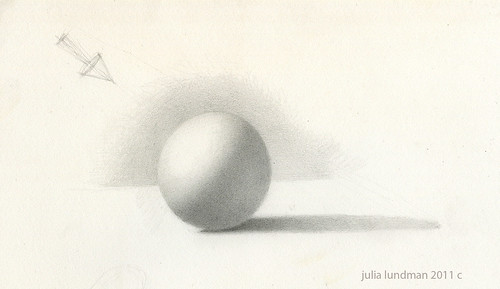
Also important to note here is that Sadie's studio is set up for North lighting, the most consistent form of natural light. We did not use any form of artificial lighting whatsoever for this course.
**note: when I was in art school we used untempered masonite panels cut to size at Home Depot, which we coated with linseed oil in the same way. these have no thumb holes but are great palettes and can also be clipped to an easel if needed.
**note: Daniel Sprick mentioned in his workshop that he coats untempered masonite panels with shellac, then five coats of Golden brand gesso, the last few coats he sands with a belt sander, and then applies Alkyd white to obliterate the texture completely making a smooth surface.
Also, we applied the couch only to an area we were working on that day because if we oiled an area we weren't painting, over the course of the day the oil would drip or become gummy.
The colors we used to mix this grey are French Ultramarine, Burnt Sienna,
After mixing up our value strings, I was more than eager to cover up the open grisaille layer. Again, I found interesting information regarding how best to apply the paint that was quite different from the Alla Prima technique I was trained in. A lot of artists learn to apply paint in values that "band" together and then blend those value bands. Sadie instructed us that this methodology does not produce a truly accurate and nuanced representation of the values and causes loss of control. It is better to instead think of the paint as small tiles that move across the form, painting each as a very small "dab" - not swiping at all - moving across the form rather than up and down. It is important not to rush or feel like you need to get it all down in one day. The importance here lies in getting as accurate as possible the values of the set up before moving on to the color stage.
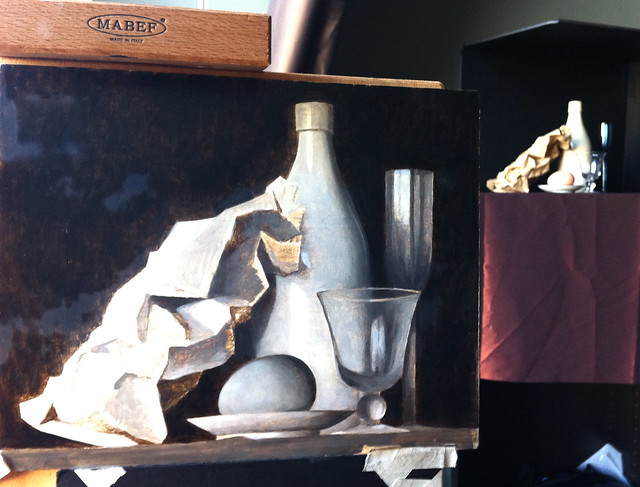
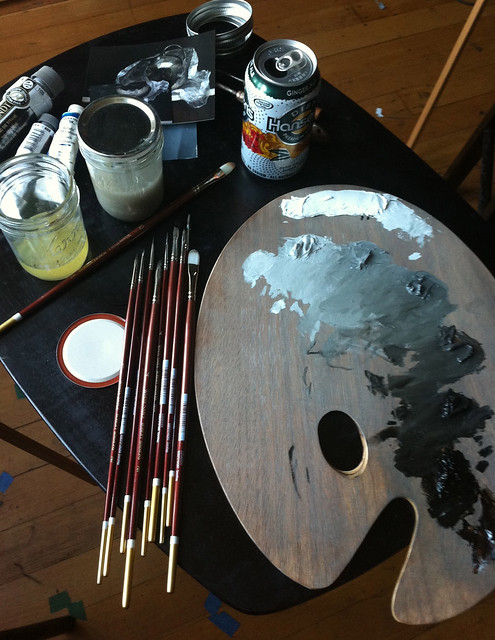
**********
After working a couple of days on refining the closed grisaille, black and white layer, we moved on to color.
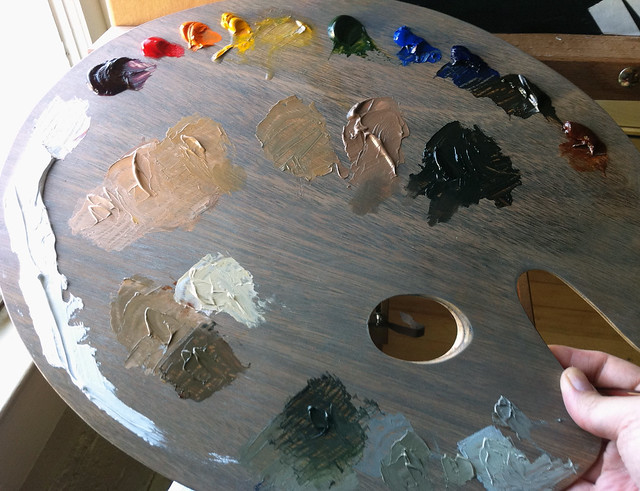
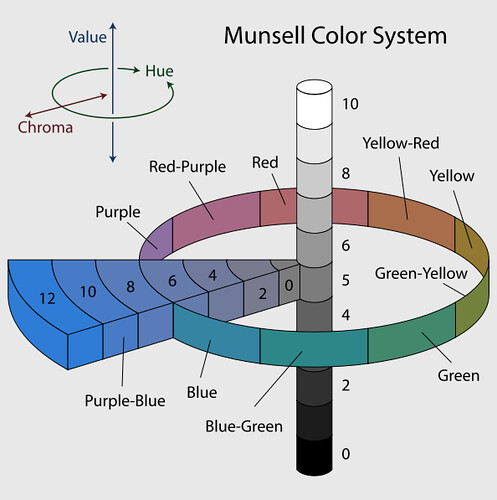
Here we started by mixing up the dark color of an object, the light color and a mid tone. We painted thicker in the lights and thinner in the shadows, commonly referred to as "thick over lean", concentrating on the lights rather than the dark colors. We typically mixed a "string" of color before painting an object.
My set up included a crumpled brown paper bag, which I was not able to complete. I mainly focused on the egg and dish, bottles and two glasses. I quite enjoyed this step and could have worked on it for much longer, but at this point the two week course was finished.
**********
**********
The methods used in this kind of painting were commonly taught in Ateliers in Europe and America, but diminished during the late 1800's through 1900's during the age of deconstruction in Western Art. (which happened in all the arts, including writing, dance, architecture, sculpture, poetry, etc) A revival has been taking place over the last thirty years for artists who wish to learn Classical painting methods driven by those who have a deep desire to depict Nature in it's true visual state. As a result, Classical Realism has become a richly poetic form of visual art in recent years thanks to the many Ateliers popping up all over the US and Europe and support by collectors world wide.
But what if you don't have a desire to paint in this manner? While I see a lot of painters begin at workshops that are loosely structured and sometimes even stylistic, I highly recommend that students begin with Classical Realism. Additionally, if you have already attended art school, Classical Realism studies will solidify accumulated knowledge and enhance an understanding of visual principles. Every form of painting, Impressionism, Alla Prima, Naturalism, even Abstract Expressionism is an off shoot of this hundreds year old tradition. Modernist avant guard schools function as a reaction to and against Classical Art tradition. Knowing this, why not fully understand the founding principles of technique and explore the truths of Nature? Once an understanding is mastered and practiced, along with the philosophy and historical context, exploring areas of visual expression is borne out of a place of understanding and relevance with a nuanced and intended expression of a visual idea.
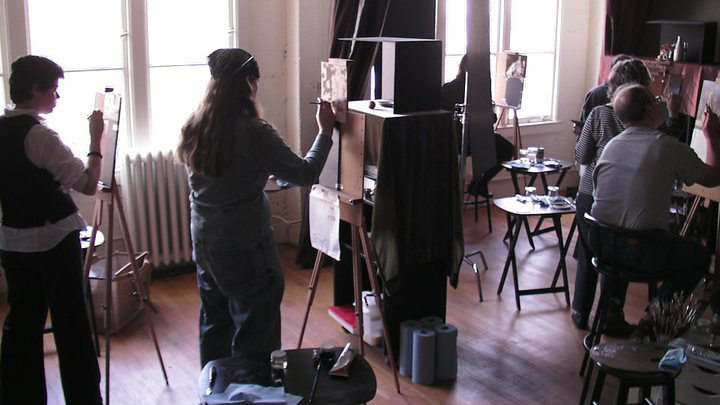
Weekend with the Masters - Daniel Sprick Demo
The painting conference was structured so that students could take several one-day courses, choosing one instructor for each day (look to my two previous blog posts for other instructors courses I attended). All twenty instructors were master painters on the Realist fine art scene; quite an impressive roster with a wide span of approaches and philosophies ranging from the alla prima direct painters, to the Rembrandt school of thought, to the Classical Realists of the East Coast atelier scene to the many noted plein air painters of the West coast.
I was surprised and delighted when I saw Daniel Sprick's name on the roster since I had never before seen offerings of workshops taught by him in the past; this was a rare treat to meet the artist I have admired for so long. I was not disappointed.
An excerpt from an article written about him on his website:
"A Vermeer-like glow infuses many of Daniel Sprick’s paintings, often falling on objects from some unseen source. It spreads arbitrarily through his interiors, picking out this tangerine and that bottle, causing their color and form to bloom, submerging other parts of the painting in warm shadow. From Vermeer too, comes the suggestion of worlds within worlds. Oriental rugs imply distant exotic places (and perhaps Sprick’s obsession with flying via magic carpet as well). Paintings and fine art prints tacked to walls, tantalizing reflections in a blank television screen, figures half-seen through distant doorways enhance the notion of time and distance. Daniel Sprick also revisits the tradition of the still life as memento mori. Yet again, in these contemporary works, the traditional images of decay and dissolution –faded flowers, broken china, eggshells, a human skull---are leavened with humorous elements such as nibbled cookies and a seeping stain that spreads from a paper bag to the book it stands on. "
-- Jane Fudge
Jane Fudge is assistant curator of modern and contemporary art at the Denver Art Museum, and a visual art and film critic.
Daniel Sprick, "Passage", 36x30, oil on board
His supply list can be found here.
Sprick explained his process for preparing panels at home, which are Masonite panels primed with golden sandable gesso. The medium he uses with his oils is Liquin.
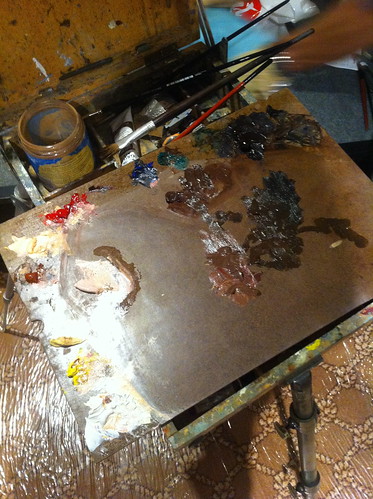
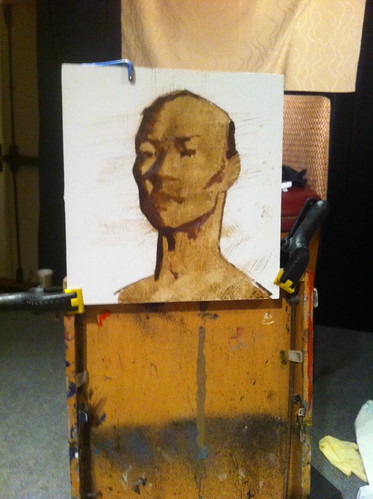
Sprick then mixed up the colors of the light in big piles from which he also used as a base for mixing middle tones.
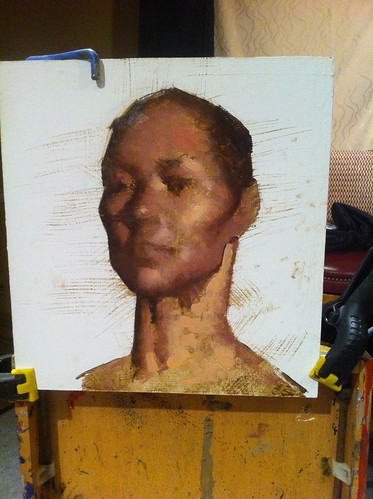
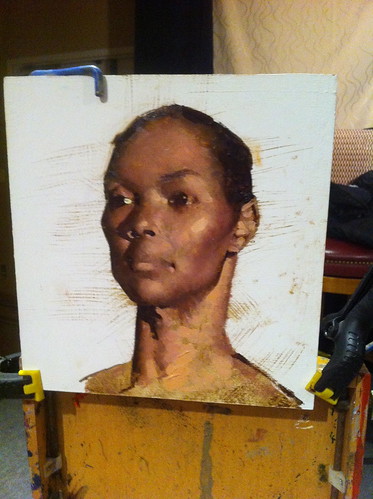
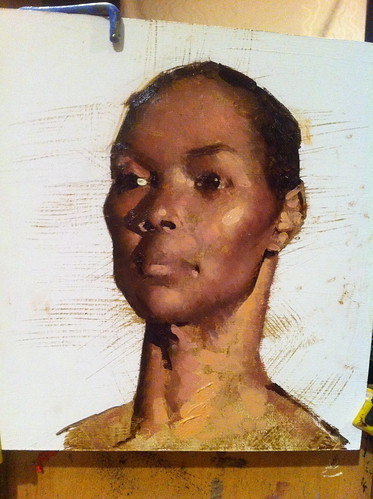
The finished demo, Daniel Sprick, 2011
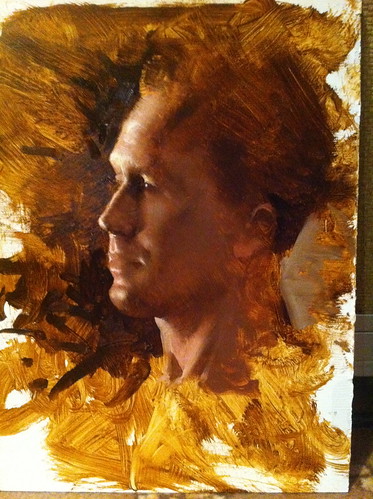
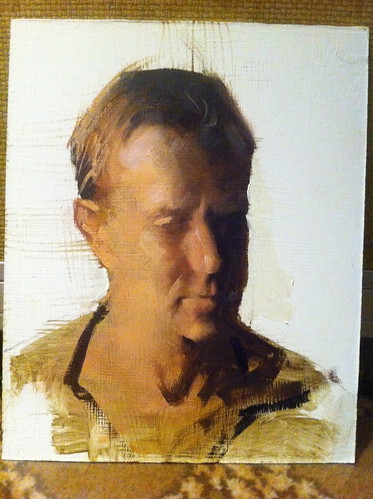
During the break at lunch time and before we painted from the model, Sprick showed us a slide show of his STUNNING portrait work on his ipad. He also talked about his interests in lighting for his still life paintings, using unusual sources of light including hot, artificial spotlights (on occasion) and interesting bounce light effects, like mirrors with blue gel on top, which bounces back into the set up. He also glazes areas of his paintings after they are completed if he finds the composition is not working the way he prefers, using the glazes to either push back or pull forward specific elements of his still life.
It was truly a joy to be in the same room with Daniel Sprick, talk with him and paint. I will not soon forget the experience!
Weekend with the Masters - Quick figure painting with Susan Lyon
I was so happy when I found that Lyon was also getting into oil quick sketching on vellum, a medium we used in art school to save on canvas, and even happier to learn she would be teaching her approach to oil quick sketch at the Weekend with the Masters, hosted by American Artist Magazine, in Monterey, California!
Here are a few samples from her blog:
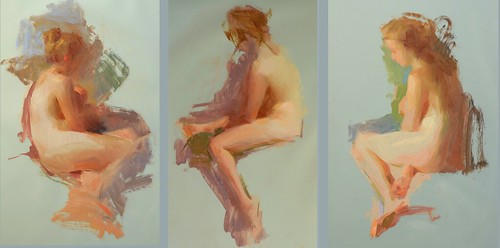
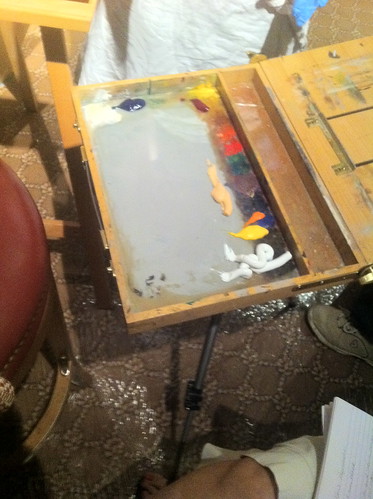
Also, as far as medium, the only one she uses is mineral spirits to wash her brushes when switching colors, which you can see on the bottom left in the photo below. To wipe off the brushes, she uses Viva paper towels.

She proceeded to mix up a few big piles of paint so that she didn't have to worry so much about mixing during the 45 minute pose. She then tapes a 14x17 piece of vellum (she has tried many variations and feels an artist needs to find which one they prefer) to a white board, and then proceeds to paint the largest shadow mass with a large bristle brush using the warm brown tone she mixed on her palette.
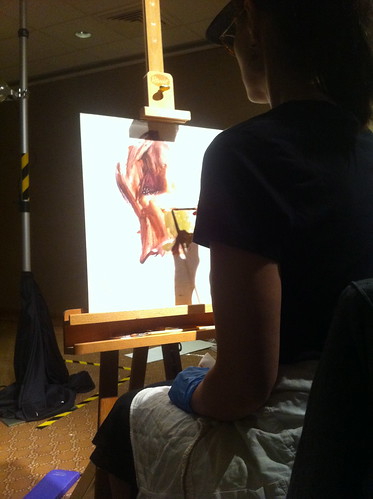
Lyon explained that after she lays in the shadow shape rather loosely, she then defines the color mass of the light areas using a loose sight size method which has become like second nature after painting for many years.
She simplifies her brushstrokes as much as possible, using only mid range values, feeling that the middle ranges tend to give a more life like feel for the figure. The only dark accents she adds are very small touches toward the end of the session.
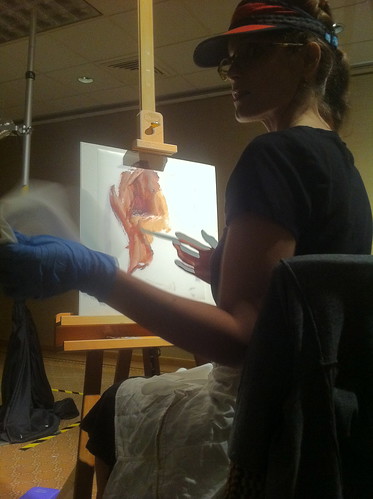
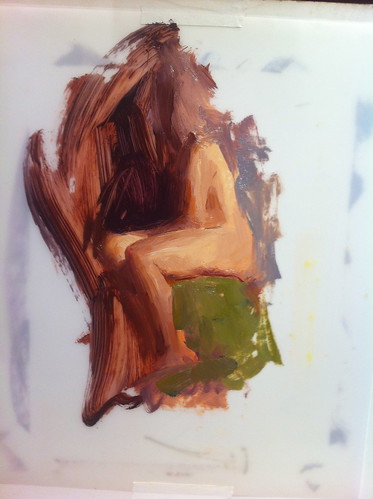
Susan Lyon's finished demo, oil on vellum, 45 minute pose.
Weekend with the Masters - David Jon Kassan demo
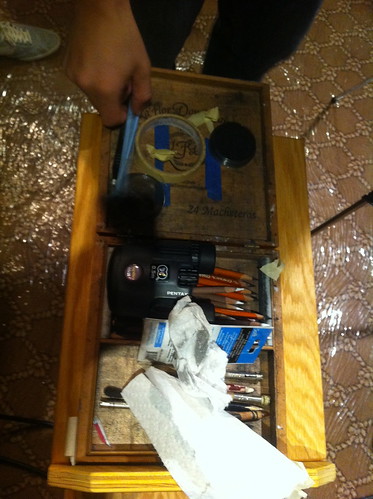
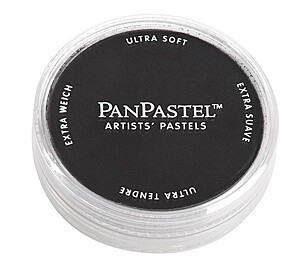 | |||

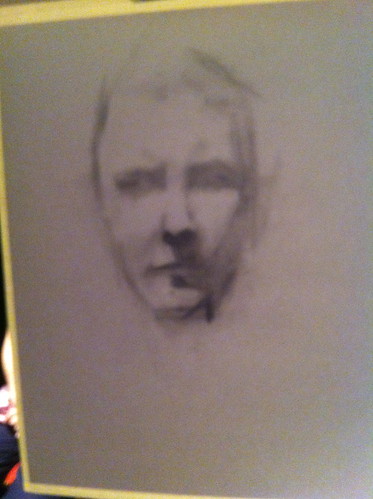
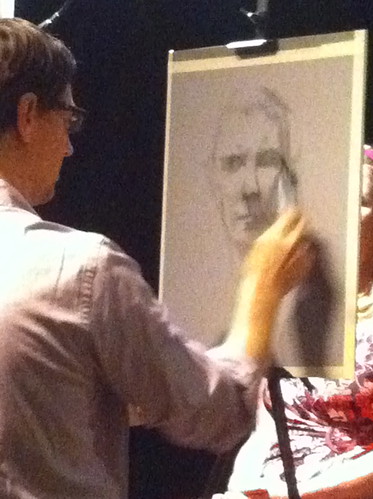
Kassan explained that the binoculars aid in finding the exact edges of shadow shapes and help in observing specifically where forms turn. He told us that occasionally students find this device controversial. His view is that while yes, binoculars are an optical aid, the mind and the hand are still creating the work; an artist still has to understand the form well enough to know what to look for in the first place as well as translate what is being seen on to the page. I have no problem with this myself. I wear eyeglasses for the same reason so binoculars to me feel like essentially the same thing.
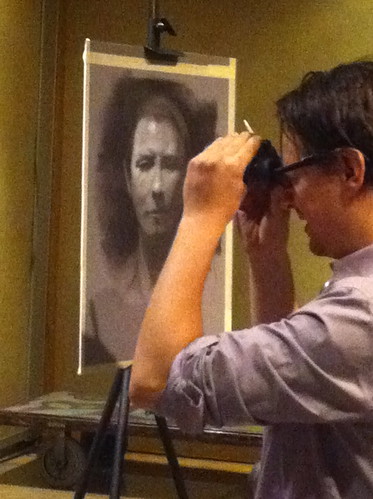
Kassan's finished 3 hour demo drawing:
While this concept might be actual fact, it does not take into account that visual language is a human way of depicting our world on to two dimensional surfaces. During a lecture given by Quang Ho, he mentioned line as a part of visual language - and it caused a bit of an on stage controversy. (more about this in subsequent posts)
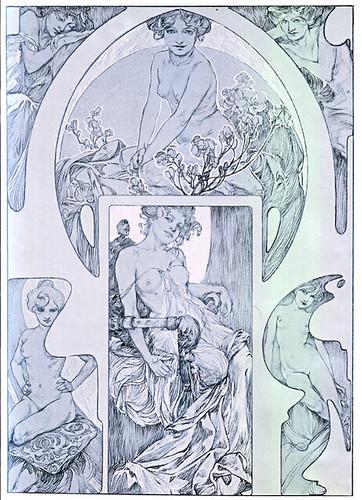
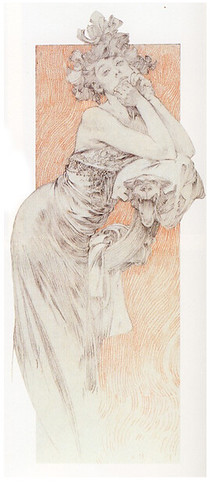
Here are some of my more recent experimentations using Langer lines:
"Tiffany", brown and white pastel pencil on Canson's Mi Tientes paper
*note: this might have been more effective had the lines followed the forms on the face and body - and if the hand were more accurately drawn.
Later in life, I have begun to realize my own internal temperament is different than those who influenced me in school, but they are still difficult to to ignore; I want to explore the idea of drawing with lines and yet I feel horribly when I do because it is the opposite of what I was taught. The only way I can address it is to break away from that line of thinking completely and put my fine art work "on hold" while I experiment with whatever I seem to gravitate toward.
So far it has been an interesting journey in finding my original influences, the things that attracted me to drawing before I even went to art school which are still deep within like a burning ember that never went out.
”…pay attention to the urges that motivate you…it’s your job to make it yours…not to judge it or compare it to other expressions…no artist is pleased…it’s just a divine dissatisfaction…a blessed unrest that keeps us marching…and makes us more alive...”
Martha Graham
Words of Wisdom

Walk on the Beach, 1909 - Sorolla
Overall, the Weekend with the Masters was a lot of process and philosophy from various top fine artists. However, most interesting were the panel discussions that tackled ponderous big questions and definitions around what Realism really means. (as a Sci Fi fan, I love contemplating what reality is - and was surprised to find many Realist painters think about such things too!)
Please stay tuned over the next couple of weeks for my notes, photos and discussion. I am eager to share!
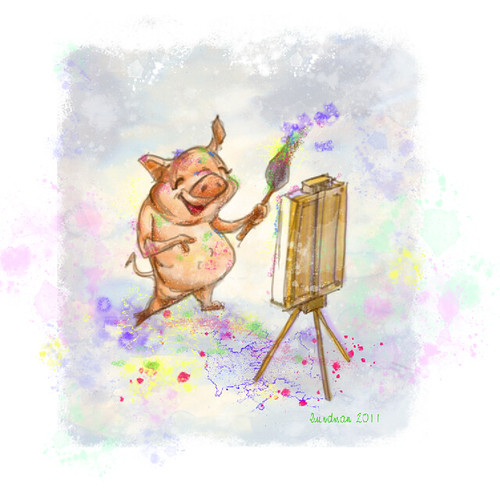
Weekend with the Masters
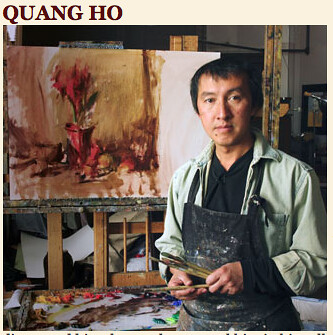
Here is a little of his biography, in his own words:
"Realism and abstraction—it's all the same to me. The real essence of painting is the dialogue between shapes, tones, colors, textures, edges, and line. Everything else follows—including light, form, concepts, personal beliefs, and inspirations. For me, painting is a marriage between the mastery of those basic visual elements, the discoveries and understanding of visual statements (the search for what is true on a personal level artistically), and the trust in one’s own intuition and inspiration. Understanding gives rise to higher understanding. Working this way allows me to open the door to new ideas and inspirations. One day I may be interested in a color statement, the next perhaps a relationship of simple shapes, and the next an extremely complex arrangement of texture and edges—with every painting there is a singular visual thought to be completed." :
I also have two sculptures in the works, which I will post about once they are complete. One is a portrait of an older man and the other a greyhound - the first animal sculpture I've ever attempted. I'm not sure if either will turn out to be successful sculptures, but I'll post about it regardless.

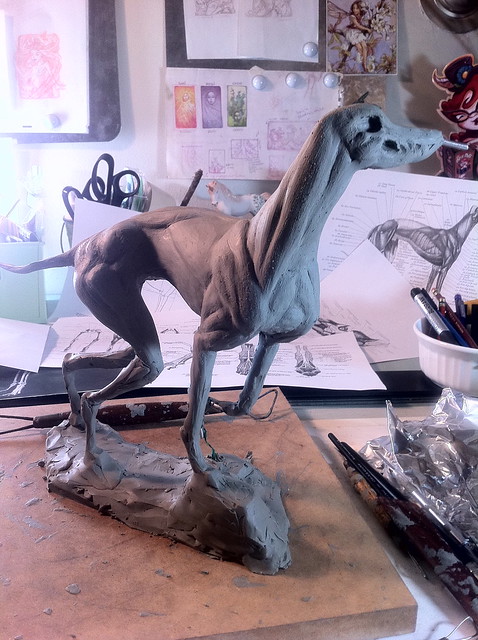
I am eager to continue sharing the things I learn and experience on my blog.
Thank you for visiting!
Bill Cone Plein Air pastel workshop
(In fact, Scott Christensen's blog "Flow" also posted about this kind of editing and interpretation in landscape painting: The Fiction of Art.)
I've thought since coming home from the workshop that I might expand my set of landscape pastels and add more colors. I am currently working on my "Spring" studio painting and would like to try a color study of it after I am finished with the pencil design.
Sadie J. Valeri's Two Week Classical Realism Workshop
It was on one of these Tuesday nights, Sadie mentioned she would be holding a ten day painting workshop, in the manner of Classical Realism, which she practices to great success. Now, I have been studying observational painting for many years now, first at the American Academy of Art in Chicago, and then at the Palette and Chisel in Chicago during the late 80's and 90's, a time when Richard Schmid was president there, a great painter to whom I am undeniably influenced. His teaching has shaped everything I know about color and light, and even the way I apply paint on a canvas, watercolor board or digitally for work. The reason I bring up my influence of Richard Schmid is because there is no doubt that his teaching shaped the way I have been painting for many years. Art schools at the time I went had pretty much thrown out the book on hundreds of years of research into how to actually paint and draw reality. For me, Schmid was and has been a life line in this regard (as well as a few amazing teachers at the American Academy of Art). For a while I sold paintings at the P&C, was in group shows, and was represented by a gallery, Jody Kirberger of the Talisman Gallery. Although I am ever grateful for my introduction to the lessons of realist painting and earned my living as an illustrator because of it, for many years I felt a strange lack of progress and improvement with my work that accumulated in my consciousness, eventually causing me to stop painting for about ten years only to focus on my professional life as an Illustrator.
It was with this background I began life drawing on Tuesday evenings. I began to feel curious about Classical Realism after having the privilege of seeing Sadie's paintings in her studio once a week. Her paintings have mesmerized me; they look more real than real, and yet also painted. I wanted to learn exactly how she is able to achieve such crispness in her work and get a general overview of what she thinks about when painting, so I signed up for her workshop.
The content of the workshop course was a true surprise to me. The first week began not with painting a still life, which I had anticipated, rather, with the fundamentals of drawing, beginning with the shading a sphere, from which all organic form is derived, then on to constructing a simple man made object, and finally, a crumbled paper bag. I must admit, at first constructing the paper bag was daunting and quite time consuming. After all, my painting goals do not necessarily include painting crumpled wax paper still lifes, as much as I appreciate Sadie’s. However, after working on the bag for an afternoon, I found the lesson enlightening on many levels, and, dare I say it...I fell in love with the complexity of form in this exquisite paper bag, thanks to Sadie’s insight into construction, a method different from the sight-size method I learned in art school.
As the class continued through the two weeks, surprises like this were often the case; my Alla Prima conventions were definitely challenged as I learned about the differing Classical Realist method regarding edges, value, chroma and hue. The second week was spent entirely on painting, two days for the black and white under painting and three days spent on color, a slow building crescendo toward the last day, when that "ah ha!" moment struck all of us workshop attendees.
All in all, Sadie's class was absolutely worth it, considering all that I have taken away. Although I am not necessarily a realist in the classic tradition, I feel that I now have a grander and more full understanding of how nature works, as well as a deeper understanding of a different Realist philosophy, a descendant of the pre-salon methods, as opposed to Alla Prima and direct painting, which descends from Impressionist ideals. I came away from the workshop with a semi finished still life, abundant notes to fuel my research for future pursuits in picture making and many, many thoughts and questions about the choices I will make in my own pursuit as a fine art painter.
In addition to all of that wonderful stuff, I’ve found that immersing myself in classical realist tradition has had an unexpected effect on me; my eye is sharper, my appreciation of artists' work more discerning (including not only realist paintings but also a finer discernment in interpretive and cartoon based illustration, which I also love), ideas about a direction for my own work have become more clear, and my love of Nature has become more profound. How fortunate to have this experience. No doubt, I am a better artist and art lover for having taken the class and the fire in my soul rekindled.
Reliquary Class at Ulla Milbrath's Studio!
I was inspired a few years ago by the reliquaries I saw on her blog after googling 'reliquaries'. I found these amazing pieces Ulla made, and discovered, even better, that she sells them at the Castle in the Air and other places, AND...she teaches classes in how to MAKE THEM.
She finally offered a class that fit with my too busy schedule, this past weekend. I couldn't wait! What a treat it was! Ulla taught me how to make each one completely from scratch using illustration board, mica, pieces of my own art, hand dyed ribbon, and - a new skill - soldering the pieces together. If you aren't familiar with a soldering iron it's like this: a very hot iron, who's tip is as hot as volcano, which you use to melt pieces of metal wire, which you then manipulate into pools of molten hotness and try not to spill on either your hands, clothing or art piece. How thrillingly DANGEROUS!
Details below each piece:

Luna is a painting I did a few months ago and sold as a print at the APE festival. For this application, I printed her out on heavy stock and cut carefully with an xacto knife around the edges. The original has fairy wings and extends to a partial view of her torso, but since this is a small piece, I sacrificed those areas for the reliquary (Perhaps sometime it would be cool to try making another one with real cicadia wings!). The cut out illustration is sitting on top of a blue fabric I lightly dusted in clear glitter and on top of that a few pieces of luscious moss. Tucked in between the moss and Luna are a few vintage flowers and a few pieces of dried baby's breath. The outside is soldered metal, which attaches the mica covering.
Learning to solder the outside was a bit challenging and intimidating, but also dangerously FUN. I can see how it becomes addicting. Melted metal is so SAUCY! haha
 "Daisy, Reliquary Portrait"
"Daisy, Reliquary Portrait"This is the very first piece I made, also using a painting I cut out and altered in order to fit the reliquary. It's still not quite working the way I want it to. But learning is all about making mistakes and trying new things. I hope to try alternate versions of this one too!
 "Mossy, Reliquary Portrait"
"Mossy, Reliquary Portrait"The tiny painting of a woman inside this piece is something I painted a few years ago. Again, I cut her out very carefully, made the box, glued together...AND, for this one, cut some glass for the very first time to make the covering. Honestly, I am in awe of the vast knowledge Ulla has in all manner of techniques! This one is a bit bigger than the others, so I thought I'd show the context by photographing it in a few places. I left the edges un-soldered (is that a word?) because I like the way the copper tape works, but also because I plan to go back and tidy up the fabric edges and trim in the back.
 Displayed next to my very small collection of Ephraim Faience hand made pottery and a pretty photo of my sister. :)
Displayed next to my very small collection of Ephraim Faience hand made pottery and a pretty photo of my sister. :)I am really excited about making more reliquaries. At the moment I don't own a soldering iron or other materials. The way I'm feeling is that the strongest one is the "Luna" portrait. I would like to try her with some cicadia wings. I also hope to make several more fairy portraits and reliquaries - maybe I'll even be able to finish some by WONDER CON! :)
Thank you so so much to my friend and inspiring artist Ulla Milbrath for spending an entire weekend teaching me the techniques involved. She worked really hard - I imagine it must be difficult to be teaching others while in your own studio, resisting the urge to make your own creations! I am deeply appreciative.
Andrew Cawrse Anatomy Workshop
On the first day we set up the model, Cason, in a kneeling pose. We quickly gestured in his form on a small armature as best we could. After a few hours of this, Andrew asked us to take our gestures off the sculpting stands and set them aside for later use at the end of the week. I thought this was a great idea and feel very happy to have gone through the exercise, although in entering the class I was not aware that we needed at this point to purchase a second, bigger armature and would have liked to know that before hand so as to be mentally prepared for the additional cost. I personally was not too miffed about this aspect since I sculpt on a weekly basis and can always use more armatures. However, I can see how others might have been a little surprised if they were new to the sculpting world. So, if you are to take Dynamic Anatomy, just know that you will need to purchase TWO armatures and probably all of the specialized tools, which end up being about $500 extra, a pretty significant cost added on to the $1500 base fee. HOWEVER, I want to emphasize here - TOTALLY worth it. (Maybe it was mentioned in the description of the class and I missed it.)
Anyway, after the first exercise, the model was posed in a standing position with a leg up on a box to show bending of the knee, a twist in the rib cage and the opposite arm up high, to demonstrate motion in the arm, rib cage and hips. We then spent the afternoon and the morning of the second day sculpting out and measuring the general proportions of the figure as best we could, which is MUCH faster than what I am used to! However, this was necessary since there was so much ground to cover in anatomy lessons. On the afternoon of the second day we began the good stuff: carving out muscle groups and indicating them on the body, specifically the legs. You can see here I didn't finish.



After we tackled the boney landmarks and muscle groups of the legs, we spent a pretty significant amount of time on the third day learning about the scapulae. Andrew and his assistant, Eric -who also assists mega alpha sculptor Richard MacDonald and is an awesome sculptor in his own right- both expressed that knowing the scapula bones are extremely important in understanding how the figure works. The reason being that the bone, although attached to the clavicle, moves and shifts as the arms and rib cage move. In addition to that, a lot of complicated muscles of the back attach to these bones, causing further confusion. However, if you become intimately familiar with the shape and function of the scapulae, the rest becomes easier to understand, and helps in making a figure look far more believable. Great lesson!
We proceeded by measuring the boney points on the model with our calipers, and sculpted out the exact shape of both scaplua as best we could. This was no easy task since both were in different positions on each side!

 During this portion of the class, I found it very helpful to refer to one of Andrew's reference figures, which he sculpted and sells on his site, www.freedomofteach.com. He also had a skeleton in the class for reference that had painted landmarks indicated in red and blue to show various points of origin and insertion of muscles on the skeletal figure. Very useful!
During this portion of the class, I found it very helpful to refer to one of Andrew's reference figures, which he sculpted and sells on his site, www.freedomofteach.com. He also had a skeleton in the class for reference that had painted landmarks indicated in red and blue to show various points of origin and insertion of muscles on the skeletal figure. Very useful!

 Next subject was the rib cage and muscles of the torso. PIECE OF CAKE compared to the back.
Next subject was the rib cage and muscles of the torso. PIECE OF CAKE compared to the back.The first step was to locate the top, bottom and width of the rib cage using the calipers to measure the model, Cason (who, btw, is a FANTASTIC model - awesome dancers body). Once we indicated these points on our sculpture, we then carved out the planes of the ribcage and drew in the ribs, sternum and clavicle. (pardon me if I'm spelling these wrong, btw)
 Once the ribs came in, we then put in the serratus anterior muscles on top. We were very lucky to have a model that had extremely well developed serratus muscles, which he believes might have developed from being on a wrestling team. Makes sense, since these become flexed to stabilize the torso.
Once the ribs came in, we then put in the serratus anterior muscles on top. We were very lucky to have a model that had extremely well developed serratus muscles, which he believes might have developed from being on a wrestling team. Makes sense, since these become flexed to stabilize the torso. next came the external obliques, which attach to the serratus anterior muscles.
next came the external obliques, which attach to the serratus anterior muscles. and after that, the pectoralis major muscles of the chest, which originate from the clavicle and rib cage and tuck in underneath the deltoids.
and after that, the pectoralis major muscles of the chest, which originate from the clavicle and rib cage and tuck in underneath the deltoids.
Here is my finished, well, half way finished, rib cage with the muscles. Behind my sculpture you can see assistant Eric's sculpture. Having Eric there was extremely beneficial to the class; we all referred to his gorgeous sculpture often to check against for errors in our own.


On Thursday evening, Andrew and his assistant Eric weighed the sculptures in order to calculate how much clay we used, which was then added to the invoice and billed accordingly. Mine weighed 20 pounds.
 And here is my semi finished sculpture! Yay! The great thing about this is that I can continue to work on it at home referring to charts and books. I hope to get it to a more completed state so I can continue to have a better understanding of how the anatomy works on a dynamic figure. The only unresolved issue I have after the class is where to put it in my studio living room. I don't think Andrew can help me with furniture rearrangement. My sculpt has ended up sitting on my floor next to my art desk. It would be better to have him on a sculpting stand of my own so I can continue to work on him.
And here is my semi finished sculpture! Yay! The great thing about this is that I can continue to work on it at home referring to charts and books. I hope to get it to a more completed state so I can continue to have a better understanding of how the anatomy works on a dynamic figure. The only unresolved issue I have after the class is where to put it in my studio living room. I don't think Andrew can help me with furniture rearrangement. My sculpt has ended up sitting on my floor next to my art desk. It would be better to have him on a sculpting stand of my own so I can continue to work on him. All in all, I highly recommend taking Andrew Cawrse's anatomy classes. I had also intended to take the next two classes, which sounded really amazing, too: Mike Murnane's creature anatomy class and Damon Bard's character sculpting class. I think regardless of what application you are eventually using these for, it would be worth the trip, the cost, the time and effort, given that you are studying with masters in the film industry whose knowledge is based in pure traditional art education, a tradition which still struggles to stay alive.
All in all, I highly recommend taking Andrew Cawrse's anatomy classes. I had also intended to take the next two classes, which sounded really amazing, too: Mike Murnane's creature anatomy class and Damon Bard's character sculpting class. I think regardless of what application you are eventually using these for, it would be worth the trip, the cost, the time and effort, given that you are studying with masters in the film industry whose knowledge is based in pure traditional art education, a tradition which still struggles to stay alive.Having said that, since this is my personal blog, I should explain that my interest in sculpting lies in a love of the craft, the beauty of the human and animal form, and very deep passion for artistic exploration. While in the class, someone asked me (and everyone else) what I wanted to do with sculpting, to which I replied with heart felt sincerity, 'nothing in particular!' After a career in illustration for animation and games, as well as a failed attempt to get a fine art painting career off the ground, I have come to a choice in how I view being an artist. That is, if I attach an expectation to where I want to eventually go with a particular skill, i.e. a GOAL or specific JOB or gallery life, I will somehow stumble on career obstacles, create a lot of frustration for myself, call into question who I am, how 'good' or 'not good' I am, and subsequently dilute the passion of whatever it is that drives me to create for MYSELF.
These days, I intentionally continue to practice the things I love in my off hours from work, without any expectation of the eventual outcome at all. I can do this partially because I already AM a working artist with a pretty stable career. So what more do I need? My personal work is just that - personal, inspired, not at all attached to money or a living, and entirely from that pure stuff within the heart that loves to create. These days, the only personal mantra I keep is: develop my passion and the rest will take care of itself. I look forward to seeing what happens, and in the mean time I am happy. Kinda like the little pink flower girl illustration below. :)
Erik Tiemens Watercolor & Gouache Painting Workshop
Tiemens' palette is largely composed of the familiar colors many painters use, but with a slightly blue and gray emphasis with brown undertones. The influence of the Dutch Masters' painting is evident in his work, which he talked about to some degree on the first day.

Tiemens' approach to painting outdoors is similar to pre-impressionist painters, who would spend time in the countryside sketching from life (usually with sepia ink or watercolor), bringing the sketches back to the studio for further development. Here is a sketch he had hanging on the wall in class (a better photo can be found on his blog):

And here is a beautiful finished painting he brought to class:
 Although Erik Tiemens works in the film industry as a well established concept artist with a great deal of respect, apart from that field he is just a really damn good painter with a lot of interesting work. It is difficult not to be inspired by his enthusiasm for the craft and history of painting.
Although Erik Tiemens works in the film industry as a well established concept artist with a great deal of respect, apart from that field he is just a really damn good painter with a lot of interesting work. It is difficult not to be inspired by his enthusiasm for the craft and history of painting.

Here are some of the field sketches I did during the workshop:


 I love the idea of sketching out in the field, 'gathering data' as he referred to it, taking those sketches and experiences back into the studio to come up with something entirely new: a composed impression based on what was learned from life. To pull this off well, a certain amount of craft and skill is involved that one must, in the end, feel as though the landscape has not been slavishly copied, but rather pulled from a well of knowledge and creativity. In the end, the artist must arrive feeling completely personally immersed in self expression. Isn't that what it's all about? I left the workshop and the beautiful town of Mendocino completely inspired and looking in a more complete direction for my own work. I highly recommend this workshop for any working illustrator or fine artist who simply loves to paint.
I love the idea of sketching out in the field, 'gathering data' as he referred to it, taking those sketches and experiences back into the studio to come up with something entirely new: a composed impression based on what was learned from life. To pull this off well, a certain amount of craft and skill is involved that one must, in the end, feel as though the landscape has not been slavishly copied, but rather pulled from a well of knowledge and creativity. In the end, the artist must arrive feeling completely personally immersed in self expression. Isn't that what it's all about? I left the workshop and the beautiful town of Mendocino completely inspired and looking in a more complete direction for my own work. I highly recommend this workshop for any working illustrator or fine artist who simply loves to paint.






















